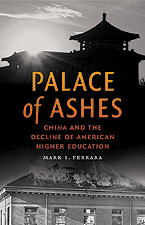
Mark S. Ferrara. Baltimore, MD: Johns Hopkins University Press, 2015; 216 pp; ISBN: 978-1-42141-799-8.
As its title suggests, this provocative book focuses on the contrast between the increasing government funding provided to Chinese higher education in recent decades and the parallel decline in financial support for American universities. The numbers are indeed disturbing: as recently as the 1970s, about 70 percent of teaching faculty at American colleges and universities were tenured or on the tenure track, and administrative responsibilities were largely undertaken by faculty members who returned to teaching once their administrative service was completed. Now less than a third of faculty members are in tenured or tenurable positions, while the remainder are on term contracts or hold adjunct positions, their work managed by a proliferating number of highly paid professional administrators.
How we arrived at this state of affairs has been well documented elsewhere. What makes Mark Ferrara’s book intriguing is the comparative study of Chinese higher education traditions and the current situation of Chinese universities. Ferrara is not a sinologist, yet his experience of teaching at Fudan University in Shanghai and his careful reading of well-chosen secondary sources enable him to paint in broad strokes. The fascinating first two chapters cover Chinese traditions of higher education, going back to Confucius himself, and the Western tradition, which is traced back to Mesopotamia, Greece, Rome, and the Islamic scholarship that stimulated the medieval universities of Europe.
Later chapters in the book focus on recent changes in Chinese and American higher education. The overview given in chapter 3, “The Chinese Moment,” captures some of these developments quite well. The account of the dramatic changes in Chinese higher education — the rapid growth of the system into the largest in the world, with more than 30 million students, and the use of enhanced funding to elevate a group of elite institutions to world-class level — should prove interesting for US readers.
I could not agree more that global ranking systems are threatening to erase all but the most superficial distinctions among global institutions, as Ferrara notes in chapter 5. With all trying to emulate the model of the “global research university” in order to rise in the rankings and gain higher levels of financial support, homogenization is inevitable. This trend reflects current tendencies around the world to focus resources on a small elite of top institutions while allowing the majority to serve local and regional teaching needs with far fewer resources. Probably as a result of its size and resilience, however, China has succeeded in maintaining considerable diversity, with normal universities, agricultural universities, and universities of minority cultures retaining unique features under national government policy.
Most instructive for the US and the wider world is the Chinese normal university. In postrevolutionary France, the creation of écoles normales to form teachers for the new republic was a stroke of genius. These schools provided the first opportunity for women to enter European higher education. The values of the école normale, including integrative and applied knowledge to foster citizenship and a high level of accountability to the public and the state, are close to the Confucian tradition. The fact that normal universities, introduced to China over 100 years ago, have been maintained and enhanced in the current Chinese system, in spite of the pressures of globalization, is a testimony to the ability of China’s Confucian tradition to challenge the global research university model and bring balance to debates around higher education.
In his afterword, Ferrara suggests ways in which America’s palaces of learning could be restored. First, he calls for a serious commitment to substantive public funding and the expansion of the number of tenurable faculty positions. Second, he pleads for a move away from the market-oriented ethos of neoliberalism and toward a model that would be democratically accountable and would encourage critical debate and activism for the public good. Meanwhile, Chinese universities have their own challenges to overcome, as Ferrara notes. Greater academic freedom within a still authoritarian Communist system is needed, as are mechanisms of transparency that can deal effectively with corruption in the relatively new market economy.
_____________________________________________
Ruth Hayhoe is professor of comparative higher education in the Ontario Institute for Studies in Education of the University of Toronto.
This book review is an abridged version of what appeared in the September–October 2016 edition of Academe published by AAUP. Reprinted with permission.